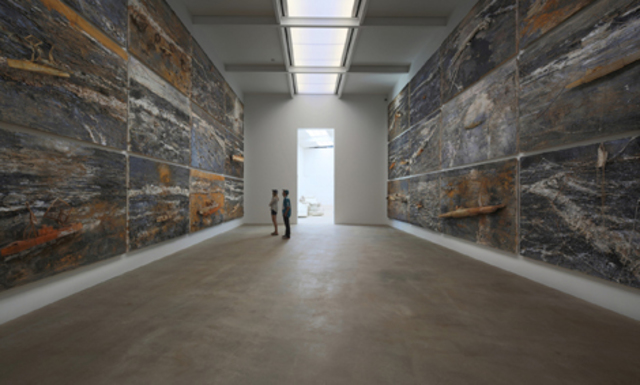
Description
Anselm Kiefer, who first visited MASS MoCA in 1990 when it was still in the early planning stages, ranks among the best-known and most important of post-World War II German artists living and working today. Born in 1945 in southern Germany during the final days of the collapse of the Third Reich, Kiefer experienced divided postwar Germany firsthand. Across his body of work, Kiefer argues with history, addressing controversial and even taboo issues from recent history with bold directness and lyricism. Kiefer often turns to literature and history as prime source material for his work, as he did, for example, in the suite of paintings that comprise Velimir Chlebnikov (2004).
The artist often builds his imagery on top of photographs, layering his massive canvases with dirt, lead, straw, and other materials that generate a ground that reads literally of the earth itself. Within these thick, impastoed surfaces Kiefer embeds textual or symbolic references to historic figures or places: these become encoded signals through which Kiefer invokes and processes history.
A law student, Kiefer switched his studies to art in 1965 and held his first solo exhibit in 1969. During the early 1970s he studied with conceptual artist Joseph Beuys, whose interest in using an array of cultural myths, metaphors, and personal symbolic vocabulary as a means to engage and understand history inspired Kiefer. The artist has described his own art-making process as stimulated by Beuys philosophies: Painting, for me, is not just about creating an illusion. I dont paint to present an image of something. I paint only when I have received an apparition, a shock, when I want to transform something. Something that possesses me, and from which I have to deliver myself. Something I need to transform, to metabolize, and which gives me a reason to paint. Like Beuys, whose works were often constructed of fragile, organic materials (including blood, fat, and honey), Kiefers works often incorporate unusual, fugitive materials such as ash, clay,and dried plant materials. With their rough-hewn textures and expansive narrative formats that often evoke charred landscape and historical, sometimes apocalyptic settings, Kiefers work did not conform to the pared-down Minimalist or Conceptualist movements that were becoming mainstream at the time he was a student. Instead he created massive, dark paintings, books constructed of large sheets of lead, and figurative works that explored German folklore and were inspired by Caspar David Friedrich, among others.
Kiefer's works are often realized in large formats, which in turn demand special exhibition spaces. MASS MoCA is adept at collaborating with artists, collectors, foundations, and cultural institutions to bring important bodies of art to the public, best exemplified by its 2008 partnership with Yale University Art Gallery, the Williams College Museum of Art, and the studio of Sol LeWitt, which realized a 25-year exhibition devoted to LeWitt's monumental wall drawings, a landmark quasi-permanent installation that was named "#1 Museum Exhibition of the Year" by Time magazine. The museum is proud to host an array of distinct curatorial points of view, within its renovated 19th singular factory campus.
Details
- Work Date:
- 2004
- Location:
- Galleries